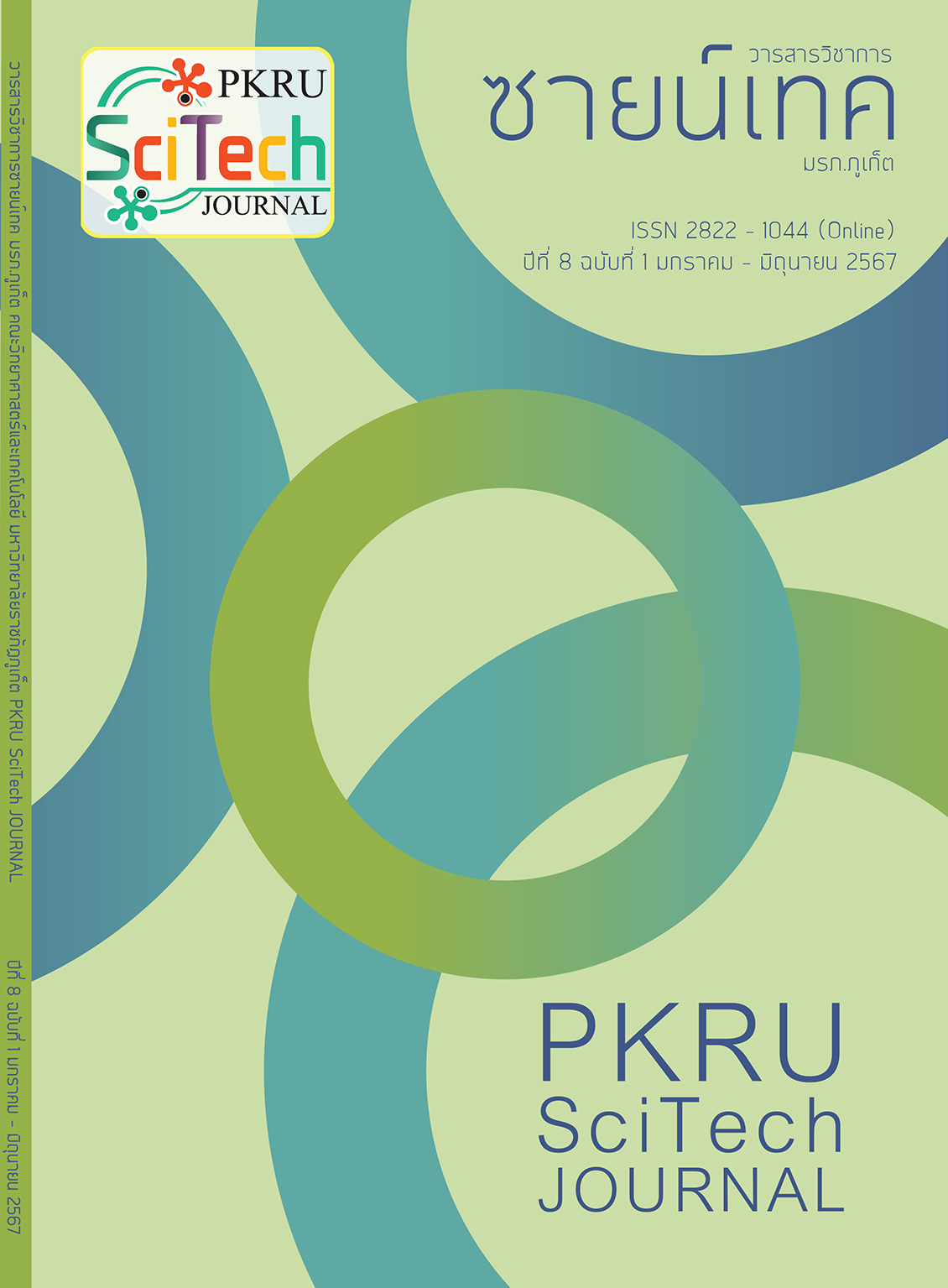Properties of Pectin Extracted from Banana Stalk and Implementation as Stabilizer in Phuket Pineapple Salad Dressing
Main Article Content
Abstract
Pectin is a plant-based hydrocolloid that has unique structure and gel-like properties. This research was to evaluate the properties of pectin extracted from banana stalk using 1.5% citric acid and followed by precipitating with 95% ethanol. Then, the extracted pectin was applied in Phuket pineapple salad dressing to increase stability and analyze product quality. The yield percentage of pectin extracted from banana stalk was 10.49 by weight. The methoxyl group content and degree of esterification (%DE) of pectin were 8.86% and 53.89%, respectively. It was revealed that the extracted pectin was classified as the high methoxyl pectin. The effect of pectin extracted from banana stalk at different levels (0%, 1%, 2%, 3% and 4% by weight) on quality of Phuket pineapple salad dressing was studied. It was found that Phuket pineapple salad dressing had lower L* and b* values but higher in a* value when the pectin content increased (p<0.05). The pH and aw values of the product were found at 4.18 and 0.91, respectively which were classified as high-acid food. Moreover, the pectin fortified product had total acidity 0.8% (w/w). The proximate composition including of moisture, ash, fat, protein, fiber and carbohydrate content was 44.03, 2.65, 8.21, 5.92, 0.01 and 39.19% (w/w), respectively. The energy value of the product was 254 kcal/100 g. The fortification of 3% pectin extracted from banana stalk in Phuket pineapple salad dressing could not only improve the texture but also maintain the stability of the product along 10 weeks storage at 4°C.
Article Details

This work is licensed under a Creative Commons Attribution-NonCommercial-NoDerivatives 4.0 International License.
- The original content that appears in this journal is the responsibility of the author excluding any typographical errors.
- The copyright of manuscripts that published in PKRU SciTech Journal is owned by PKRU SciTech Journal.
References
Preethi, P., & Balakrishna M. G. (2013). Physical and chemical properties of banana fiber extracted from commercial banana cultivars grown in Tamilnadu state. Agrotechnology, S11(008), 1-3.
Pereira, A. L., do Nascimento, D. M., Souza, M. S. M., Cassales, A. R., Morais, J. P. S., de Paula, R. C. M., Rosa, M. F., & Feitosa, J. P. A. (2014). Banana (Musa sp. Cv. Pacovan) pseudostem fibers are composed of varying lignocellulosic composition throughout the diameter. BioResources, 9(4), 7749-7763.
Wedamulla, N. E., & Wijesinghe, W. A. J. P. (2021). Application of Polysaccharides in Food Technology: A Review. Trends In Carbohydrate Research, 13(2), 35-49.
สุดารัตน์ ตัญเจริญสุขจิต และ ศศิธร จันทนวรางกูร. (2550). ความสามารถในการต้านออกซิเดชันของเปลือก แกนและเนื้อสับปะรดพันธุ์ปัตตาเวียและพันธุ์ภูเก็ต (หน้า 656-663). ใน การประชุมทางวิชาการของมหาวิทยาลัยเกษตรศาสตร์ ครั้งที่ 45. กรุงเทพฯ.
Castillo-Israel, K. A. T., Baguio, S. F., Diasanta, M. D. B., Lizardo, R. C. M., Dizon, E. I., & Mejico, M. I. F. (2015). Extraction and characterization of pectin from saba banana [Musa acuminate x Musa balbisiana] peel wastes: a preliminary study. International Food Research Journal, 22(1), 202-207.
Kamble, P. B., Gawande, S., & Patil, T. S. (2017). Extraction of pectin from unripe banana peel. Food Technology, 4(7), 2259-2264.
นวลกมล อำนวยสิน ณัฐญาภรณ์ เสือชุมแสง และ เทพปัญญา เจริญรัตน์. (2561). การหาสภาวะที่เหมาะสมในการสกัดเพคทินจากเปลือกกล้วยหอมทองด้วยกรดไฮโดรคลอริกและกรดซิตริก. วารสารวิทยาศาสตร์และเทคโนโลยี, 7(5), 481-490.
Maneerat, N., Tangsuphoom, N., & Nitithamyong, A. (2017). Effect of extraction condition on properties of pectin from banana peels and its function as fat replacer in salad cream. Journal of Food Science and Technology, 54(2), 386–397.
สุปรียา ยืนยงสวัสดิ์ และ สุดใจ คงทอง. (2537). การศึกษาคุณสมบัติของสารสกัดโพลีแซกคาไรด์จากเปลือกกล้วยไข่ กล้วยน้ำว้า และกล้วยหอม (รายงานผลการวิจัย). สงขลา: มหาวิทยาลัยสงขลานครินทร์ วิทยาเขตหาดใหญ่.
สุนันท์ วิทิตสิริ. (2557). การเปรียบเทียบปริมาณเพกทินจากซังขนุนหนังจำปากรอบโดยการสกัดด้วยน้ำร้อนและความดันไอสูง. วารสารมหาวิทยาลัยราชภัฏยะลา, 9(2), 95-112.
AOAC. (1999). Official Methods of Analysis of the Association of Official Analytical Chemists (16th edition). Washington, DC: The Association of Official Analytical Chemists, Inc.
Manilal, V. B., & Sony, J. (2011). Banana pseudostem characterization and its fiber property evaluation on physical and bioextraction. Journal of Natural Fibers, 8,
–12.
Li, K., Fu, S., Zhan, H., Zhan, Y., & Lucia, L. A. (2010). Analysis of the chemical composition and morphological structure of banana pseudo-stem. BioResources, 5(2), 576-585.
Sundar Raj, A. A., Rubila, S., Jayabalan, R., & Ranganathan, T. V. (2012). A review on pectin: Chemistry due to general properties of pectin and its pharmaceutical uses. Open Access Scientific Reports, 12(1), 1-5.
Ngouémazong, E. D., Christiaens, S., Shpigelman, A., Loey, A. V., & Hendrickx, M. (2015). The emulsifying and emulsion-stabilizing properties of pectin: A review. Comprehensive Reviews in Food Science and Food Safety, 14, 705-718.
Gawkowska, D., Cybulska, J., & Zdunek, A. (2018). Structure-related gelling of pectins and linking with other natural compounds: a review. Polymers, 4, 20-29.
Sriamornsak, P. (2003). Chemistry of pectin and its pharmaceutical uses: A review. Silpakorn University International Journal, 3(1-2), 206-228.
Evanuarini, H., & Susilo, A. (2020). The quality of low fat mayonnaise using banana peel flour as stabilizer. Earth and Environmental Science, 54(2), 386-397.
Ma, Z., & Boye, J. I. (2013). Advances in the design and production of reduced-fat and reduced-cholesterol salad dressing and mayonnaise: a review. Food Bioprocess Technology, 6(3), 648-670.
กรวิทย์ สักแกแก้ว พรทิพย์ พสุกมลเศรษฐ์ และ น้องนุช ศิริวงศ์ (2563). ผลของการทดแทนไขมันด้วยเพคตินจากเปลือกแก้วมังกรต่อคุณสมบัติทางกายภาพและเคมีของน้ำสลัด. วารสารวิทยาลัยดุสิตธานี, 14(3), 328-342.
สำนักงานมาตรฐานผลิตภัณฑ์อุตสาหกรรม. (2540). มาตรฐานผลิตภัณฑ์อุตสาหกรรม มายองเนสและสลัดครีม (มอก. 1402-2540). กรุงเทพฯ: กระทรวงอุตสาหกรรม.


